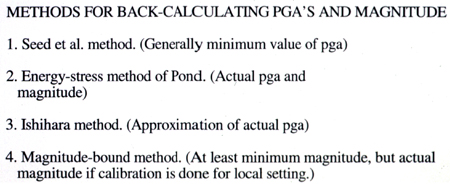

45. Various geotechnical methods can be
used for analyzing prehistoric strength of shaking by using effects
of liquefaction from the prehistoric earthquakes. This presentation
does not discuss the various methods in detail because that in
itself would be a long endeavor. Only a brief summary of results
will be given for the Wabash Valley region. (Strengths and shortcomings
of each geotechnical method are discussed by Obermeier and Pond,
1999.)
Three geotechnical methods were used in the Wabash Valley study area: the Seed et al. method, the energy-stress procedure (a new method that was developed as part of the study), and the magnitude-bound (farthest liquefaction) method. The two methods best for the study area were the energy-stress procedure and the liquefaction-bound method; both provided an estimate of the actual magnitude of the paleo-earthquake. Both yielded the same values of prehistoric magnitudes for the four largest paleo-earthquakes (which were the only paleo-earthquakes studied in detail). This agreement gave considerable credibility to interpretations of prehistoric magnitudes.
For more information, contact Stephen F. Obermeier